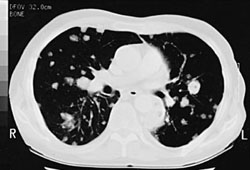Resumen
Definición
Anamnesis y examen
Principales factores de diagnóstico
- presença de fatores de risco
- tosse com escarro purulento
- febre
Otros factores de diagnóstico
- cefaleia
- náuseas e vômitos
- confusão
- consciência deprimida
- úlceras ou abscessos cutâneos
Factores de riesgo
- receptores de transplante de órgão sólido e de células-tronco hematopoéticas
- positivo ao vírus da imunodeficiência humana (HIV-positivo) e baixa celularidade de células T CD4 (<100 células/mm³)
- imunossupressão
- doença pulmonar estrutural
- malignidade e quimioterapia
- trabalho agrícola
Pruebas diagnósticas
Primeras pruebas diagnósticas para solicitar
- Colorações de Gram e álcool-ácido resistente
- cultura
- tecnologia de ionização-dessorção a laser assistida por matriz acoplada a espetrometria de massa por tempo de voo (MALDI-TOF MS)
- tipagem bioquímica da espécie
- técnicas baseadas em reação em cadeia da polimerase
- radiografia torácica
- tomografia computadorizada (TC) do crânio
Pruebas diagnósticas que deben considerarse
- tomografia computadorizada (TC) do tórax
- ressonância nuclear magnética (RNM) de crânio
Pruebas emergentes
- sequenciamento de última geração
Algoritmo de tratamiento
nocardiose grave: doença disseminada, envolvimento do sistema nervoso central (SNC), lesões pulmonares cavitárias ou imunocomprometimento
nocardiose não grave: imunocompetente, não disseminada, sem envolvimento do sistema nervoso central (SNC), sem lesões pulmonares cavitárias
Colaboradores
Autores
Timothy Sullivan, MD
Associate Professor
Division of Infectious Diseases
Icahn School of Medicine at Mount Sinai
New York
NY
Divulgaciones
TS declares that he has no competing interests.
Agradecimientos
Dr Timothy Sullivan would like to gratefully acknowledge Dr Jorge Garbino and Dr Juan Ambrosioni, previous contributors to this topic.
Divulgaciones
JG declares that he has no competing interests. JA is an advisory board member of Gilead Sciences and ViiV Healthcare.
Revisores por pares
Senu Apewokin, MD
Associate Professor of Medicine
Director, Transplant Infectious Diseases
University of Cincinnati
Cincinnati
OH
Divulgaciones
SA declares that she has no competing interests.
Rebecca N. Kumar, MD, MS
Assistant Professor of Medicine
Georgetown University Medical Center
Washington
DC
Divulgaciones
RNK has received research grants from Regeneron and Gilead, which have been paid to Georgetown University.
Agradecimiento de los revisores por pares
Los temas de BMJ Best Practice se actualizan de forma continua de acuerdo con los desarrollos en la evidencia y en las guías. Los revisores por pares listados aquí han revisado el contenido al menos una vez durante la historia del tema.
Divulgaciones
Las afiliaciones y divulgaciones de los revisores por pares se refieren al momento de la revisión.
Referencias
Artículos principales
Brown-Elliott BA, Brown JM, Conville PS, et al. Clinical and laboratory features of the Nocardia spp. based on current molecular taxonomy. Clin Microbiol Rev. 2006 Apr;19(2):259-82.Texto completo Resumen
Hamdi AM, Fida M, Deml SM, et al. Retrospective analysis of antimicrobial susceptibility profiles of Nocardia species from a tertiary hospital and reference laboratory, 2011 to 2017. Antimicrob Agents Chemother. 2020 Feb 21;64(3):e01868-19.Texto completo Resumen
Corti ME, Villafane-Fioti MF. Nocardiosis: a review. Int J Infect Dis. 2003 Dec;7(4):243-50.Texto completo Resumen
Margalit I, Lebeaux D, Tishler O, et al. How do I manage nocardiosis? Clin Microbiol Infect. 2021 Apr;27(4):550-8.Texto completo Resumen
Restrepo A, Clark NM, Infectious Diseases Community of Practice of the American Society of Transplantation. Nocardia infections in solid organ transplantation: guidelines from the Infectious Diseases Community of Practice of the American Society of Transplantation. Clin Transplant. 2019 Sep;33(9):e13509. Resumen
Artículos de referencia
Una lista completa de las fuentes a las que se hace referencia en este tema está disponible para los usuarios con acceso a todo BMJ Best Practice.

Diferenciales
- Tuberculose
- Actinomicose
- Abscesso pulmonar
Más DiferencialesGuías de práctica clínica
- Nocardia infections in solid organ transplantation
Más Guías de práctica clínicaInicie sesión o suscríbase para acceder a todo el BMJ Best Practice
El uso de este contenido está sujeto a nuestra cláusula de exención de responsabilidad